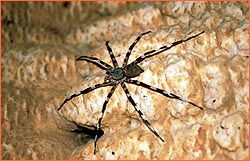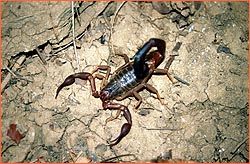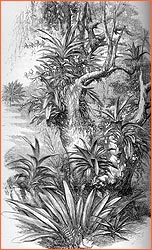 |

|

|
by Peter Tyson One of the many extraordinary facts about Madagascar is that it bears virtually no dangerous animals. Save for the Nile crocodile (see Close Calls with Crocs), all of Africa's big beasts are missing, because Madagascar drifted out of range of the continent that gave it birth long before rhinos and lions and pythons and apes evolved. The island's paucity of menacing creatures gives the visitor to its storied wilderness a delightful sense of immunity. And that's where the problem lies. You become fearless, and you forget that there are plenty of things—animal, plant, and otherwise—that can get you in the forests of the world's fourth-largest island. Both places we will visit during this expedition (see The Mission) bristle with many of these nasty surprises. Skin deep Your skin is a favorite target for certain Malagasy fauna and flora. (Malagasy is the name for the people, language, and other things Madagascan.) In the spiny desert, an otherworldly ecosystem in the deep south, I learned to break into a sprint whenever I heard anything remotely resembling a buzz, for it usually belonged to a yellow wasp that stings without provocation. If you even come near its nest, you soon find yourself screaming and slapping and running for your life. While searching for a rare species of gecko beneath the frayed bark of a certain kind of spiny-desert tree, I learned to work delicately, for such refuges often harbored a seething mass of scorpions, tarantulas, and giant hissing cockroaches. A friend bending down to examine a curious-looking insect got hydrochloric acid spit in her face; when another friend went to her aid, he got his own dose of the bombardier beetle's juice.
I feel bad. I kneel up, lie down, lie propped up, curl up. Take some morphine. The water to wash the tablets down feels like swallowing red hot tintacks. There is a lump in my throat. My nose and sinuses are congested and my eyes stream. Blowing my nose provokes a wave of severe pain in my face. My throat feels tight and I begin to worry that my airway is closing up. I have never even seen a tracheotomy performed. I vaguely know where to make the incision, but I do not fancy teaching someone how to cut into my throat while I am asphyxiating. Certain plants can be equally vicious. An Englishman traveling by canoe down the Ikopa River in western Madagascar in 1875 had a horrific surprise in store when he stepped ashore: ...I was startled in a moment, by a sudden tingling and pricking sensation over the back of my hands and fingers...I stopped at once in sudden surprise, for the pain was severe, and I had touched nothing, save perchance the long grass and rushes between the trees. But in another moment the pain increased, the tingling burning sensation seemed extending rapidly up my wrists; and as I bent my head down to look closely for the cause of the mischief, nothing was seen. But even as I lowered my head to look, pain, scalding pain, shot into my ears and neck, and growing worse too, every instant. Dazed and bewildered, I stood a few seconds in helplessness, for I could neither see nor guess at the cause of the terrible distress.
A friend of mine told me about the ingenious procedure his Malagasy guide used to remove hair-like spines of the prickly pear, a non-native plant that infests the south. The spines had become stuck like miniature acupuncture needles in my friend's hands while he unsuspectingly dined on the cactus's delicious fruit. The guide snatched a fly off the belly of a zebu, the lyre-horned cattle of Madagascar, held it by its wings, and let its scrabbling legs pull out the spines. Continue: Eye Sore The Expedition | Surviving The Wilds | Explore Madagascar Dispatches | Classroom Resources | E-Mail | Resources Site Map | The Wilds of Madagascar Home Editor's Picks | Previous Sites | Join Us/E-mail | TV/Web Schedule About NOVA | Teachers | Site Map | Shop | Jobs | Search | To print PBS Online | NOVA Online | WGBH © | Updated November 2000 |
 Madagascar's dearth of large creatures that can hurt you lulls you into forgetting about little creatures that can hurt you, like this deadly poisonous spider from the Ankarana caves.
Madagascar's dearth of large creatures that can hurt you lulls you into forgetting about little creatures that can hurt you, like this deadly poisonous spider from the Ankarana caves.
 The Ankarana is loaded with scorpions, which like nothing better than to crawl into your sleeping bag at night.
The Ankarana is loaded with scorpions, which like nothing better than to crawl into your sleeping bag at night.
 The Malagasy forest contains hidden surprises such as the agy vine, which rains nettle-like hairs down on unsuspecting passerby.
The Malagasy forest contains hidden surprises such as the agy vine, which rains nettle-like hairs down on unsuspecting passerby.